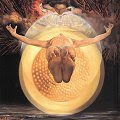GOD HAS GONE UP WITH A SHOUT
Today, forty days after Easter Day, is Ascension Day, which the Church names (BCP 15) as one of the seven Principal Feasts. In the Roman Catholic Church this is a holy day of obligation, but because people don’t come to Mass, some dioceses have, with Vatican permission, moved the observance to the following Sunday.
In the Episcopal Church the Masses are largely not even offered, much less would people attend, and so the Lectionary for the Seventh Sunday of Easter provides for the observance by appointing Acts 1:6-14 as a Lesson (BCP 895).
When and what was the Ascension? Luke, who wrote both the Gospel according to Luke and the Acts of the Apostles, has it two ways. At Luke 24:50-53 the ascension takes place on the evening of Easter Day at Bethany, just outside Jerusalem. At Acts 1:6-14 the ascension takes place forty days after Easter Day, and the place seems ambiguous, at Mount Olivet a “sabbath day’s journey away” from Jerusalem, or perhaps in Galilee. Doesn’t matter, and the history is beyond knowing anyway; some ancient manuscripts of Luke say Jesus was “taken up into heaven” and some do not say that.
In the Episcopal Church the Masses are largely not even offered, much less would people attend, and so the Lectionary for the Seventh Sunday of Easter provides for the observance by appointing Acts 1:6-14 as a Lesson (BCP 895).
When and what was the Ascension? Luke, who wrote both the Gospel according to Luke and the Acts of the Apostles, has it two ways. At Luke 24:50-53 the ascension takes place on the evening of Easter Day at Bethany, just outside Jerusalem. At Acts 1:6-14 the ascension takes place forty days after Easter Day, and the place seems ambiguous, at Mount Olivet a “sabbath day’s journey away” from Jerusalem, or perhaps in Galilee. Doesn’t matter, and the history is beyond knowing anyway; some ancient manuscripts of Luke say Jesus was “taken up into heaven” and some do not say that.
A painting by German artist von Kulmbach (1480-1521) (Met NYC, I think) depicts the ascension with the apostles gazing up as Jesus’ feet disappear into a cloud.
The Rembrandt is perhaps the best known depiction:
Salvadore Dali (1948) is interesting:
My all time favorite is the stained glass window over the Altar in Trinity Episcopal Church, Apalachicola. Beautiful, the work is most magnificent at night when the outside spotlights are turned on. Many, many nights when Kristen was tiny and fussy at bedtime, I took her next door into the church with her stroller, and we strolled round and round the nave at night, with her staring at the brilliant window until she became drowsy and dozed off. It is one of my very happy memories, and that depiction of the Ascension is forever the one I love most.
My favorite image of the Ascension though is not in art or even in the New Testament at all, but in Psalm 47, which is appointed for today:
Psalm 47 (KJV)
O clap your hands, all ye people; shout unto God with the voice of triumph. For the LORD most high is terrible; he is a great King over all the earth. He shall subdue the people under us, and the nations under our feet. He shall choose our inheritance for us, the excellency of Jacob whom he loved. Selah.
God is gone up with a shout, the LORD with the sound of a trumpet. Sing praises to God, sing praises: sing praises unto our King, sing praises. For God is the King of all the earth: sing ye praises with understanding.
God reigneth over the heathen: God sitteth upon the throne of his holiness. The princes of the people are gathered together, even the people of the God of Abraham: for the shields of the earth belong unto God: he is greatly exalted.
If the history of the Ascension is beyond knowing, the vision of it, as art shows, is open to the imagination of the faithful; and the theology of it seems adequately expressed in the Proper Preface for the Day, which combines words of Luke/Acts and the Gospel of John:
Through your dearly beloved Son Jesus Christ our Lord. After his glorious resurrection he openly appeared to his disciples, and in their sight ascended into heaven, to prepare a place for us; that where he is, there we might also be, and reign with him in glory.
God has gone up with a shout! TW+



